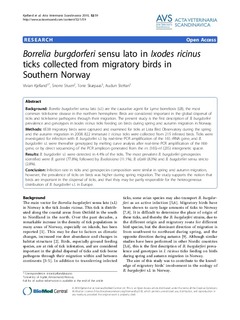Borrelia burgdorferi sensu lato in Ixodes ricinus ticks collected from migratory birds in Southern Norway
Journal article, Peer reviewed
Permanent lenke
http://hdl.handle.net/11250/138242Utgivelsesdato
2010Metadata
Vis full innførselSamlinger
Originalversjon
Kjelland, V., Stuen, S., Skarpaas, T., & Slettan, A. (2010). 2Borrelia burgdorferi sensu lato in Ixodes ricinus ticks collected from migratory birds in Southern Norway. Acta Veterinaria Scandinavica, 52(1). doi: 10.1186/1751-0147-52-59Sammendrag
BACKGROUND:Borrelia burgdorferi sensu lato (s.l.) are the causative agent for Lyme borreliosis (LB), the most common tick-borne disease in the northern hemisphere. Birds are considered important in the global dispersal of ticks and tick-borne pathogens through their migration. The present study is the first description of B. burgdorferi prevalence and genotypes in Ixodes ricinus ticks feeding on birds during spring and autumn migration in Norway.METHODS:6538 migratory birds were captured and examined for ticks at Lista Bird Observatory during the spring and the autumn migration in 2008. 822 immature I. ricinus ticks were collected from 215 infested birds. Ticks were investigated for infection with B. burgdorferi s.l. by real-time PCR amplification of the 16S rRNA gene, and B. burgdorferi s.l. were thereafter genotyped by melting curve analysis after real-time PCR amplification of the hbb gene, or by direct sequencing of the PCR amplicon generated from the rrs (16S)-rrl (23S) intergenetic spacer.RESULTS:B. burgdorferi s.l. were detected in 4.4% of the ticks. The most prevalent B. burgdorferi genospecies identified were B. garinii (77.8%), followed by B.valaisiana (11.1%), B. afzelii (8.3%) and B. burgdorferi sensu stricto (2.8%).CONCLUSION:Infection rate in ticks and genospecies composition were similar in spring and autumn migration, however, the prevalence of ticks on birds was higher during spring migration. The study supports the notion that birds are important in the dispersal of ticks, and that they may be partly responsible for the heterogeneous distribution of B. burgdorferi s.l. in Europe.
Beskrivelse
Published version of an article in the journal: Acta Veterinaria Scandinavica. Also available from the publisher: http;//dx.doi.org/10.1186/1751-0147-52-59. Open Access
